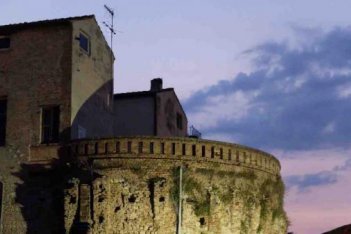- Home
- Punti di interesse
- Contrada di Porta Madonna dello Splendore o da capo: il Torrione di Porta Santa Maria e il Palazzo Re
Descrizione
In Contrada di Porta Madonna dello Splendore o da capo, all'estremo del corso Garibaldi, sorge Palazzo Re, di proprietà del prof. Luigi Re, è tra le testimonianze architettoniche più significative delle trasformazioni urbanistiche e sociali che interessarono la città dopo l’Unità d’Italia.
Come una sezione stratigrafica, il fabbricato permette di visitare l’interno di uno dei torrioni più grandi della cinta muraria quattrocentesca con la sua ampia volta cupoliforme, e la residenza costruita a partire dagli anni ottanta dell’Ottocento, con le sue stanze decorate con motivi Liberty.
Inoltre, dalla terrazza realizzata sulla sommità del bastione si scopre una straordinaria veduta sul mare e sul complesso disegno urbanistico della città.
---ENG---
In the "Porta Madonna dello Splendore" district, or at the end of Corso Garibaldi, you will find the Re Palace, owned by Prof. Luigi Re, who is one of the most important architectural testimonies of the urban and social transformations that affected the city after the unification of Italy.
Like a stratigraphic section, the building allows you to visit the interior of one of the largest towers of the city walls, dating from the 15th century, with its large dome shaped vault and the residence built from 1880 with its rooms decorated in Art Nouveau style.
In addition, from the terrace built on the highest point of the bastion, there is an exceptional view of the coast and the whole urban layout of the city.
---DE---
Im Quartier „Porta Madonna dello Splendore“ oder am Ende des Corso Garibaldi, findet man den Palast Re, im Besitz von Prof. Luigi Re, der zu den bedeutendsten architektonischen Zeitzeugnissen der urbanen und sozialen Transformationen, die die Stadt nach der Vereinigung Italiens betrafen, gehört.
Wie ein stratigraphischer Schnitt ermöglicht das Gebäude den Besuch des Inneren eines der größten Türme der Stadtmauer aus dem 15. Jahrhundert mit seinem großen kuppelförmigen Gewölbe und dem, ab 1880 erbauten Wohnsitz mit ihren im Jugendstil geschmückten Räumen.
Darüber hinaus hat man von der Terrasse, die auf dem höchsten Punkt des Bastions errichtet wurde, einen außergewöhnlichen Blick auf die Küste und die komplette urbane Gestaltung der Stadt.

